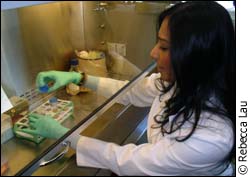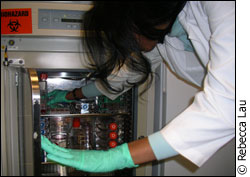
|
| Like most medical scientists, Dr. Paul MacPherson of the Ontario Health Research Institute is leery to speak in terms of a cure. But he says he believes alternative and more aggressive treatments are attainable. "The playing field is wide open," he says. "The barriers to developing new treatments are simply lack of knowledge." The face of HIV has changed; there's been a shift in the types of people infected and a major upswing in life expectancy. But researchers still don't know how the virus is capable of attacking the immune system, and so, medication continues to be a suppressant and not a cure. For MacPherson and his colleagues, the answer to breaking that barrier may lie in the IL-7 receptor molecule. What is HIV? HIV inactivates the immune system, and as the name implies, causes immune deficiency. "HIV doesn't kill people. It simply [makes] them vulnerable to other organisms and cancers," MacPherson explains.
The virus attacks T-cells such as CD4 and reproduces to attack more cells. T-cells are vital because they direct the body's defence against pathogens, which are agents that cause disease. Pathogens can range from viruses to bacteria, and fungi. Once T-cells are depleted and the CD4 cell counts dip below 200, the immune system can no longer fight invading virus cells. It is at this point when a patient is diagnosed with Acquired Immune Deficiency Syndrome, or AIDS. According to MacPherson, there are currently close to 20 different HIV drugs available on the market. These drugs act to hold HIV "in check" by inactivating the virus so it can't replicate or attack the immune system. He explains that current medications work within the CD4 T-cell. Drugs act inside the T-cell and prevent replications, however, HIV is still present in the body. "So long as the virus is suppressed by medication, the immune system is able to repair itself." MacPherson says current medications have a ver
igh success rate. He says in 1995, 1,051 Canadians died as a result of complications from HIV. In 2004, with the availability of effective HIV medication, only 74 people died. He estimates that without treatment, a patient has about 10 years to live after infection. The survival rates of those using HIV drugs are unknown, he says, because they are still alive. "The drugs have only been around for 10 years, but I tell my patients to plan to grow old [and] invest in their RRSPs." Current drugs are limited, however, in that they can only suppress the virus. The research For MacPherson and his team of researchers, the next step was to find a way to prevent HIV from attacking T-cells in the first place or remove the virus after infection. In 2001, the scientists published a study on the role of the Interleukin-7, or IL-7, receptor molecule and its role in detecting HIV in cells. The study concentrated on the CD8 T-cell, which interacts with HIV in a manner different than CD4. Unlike CD4, which becomes infected with HIV, the virus only affects CD8. The cell is able to recognize and detect intruding pathogens through T-cell receptors, such as the IL-7 molecule. In the same way that security cameras work to detect intruders within a building, IL-7 finds pathogens so that the CD8 T-cell is able to kill them.
MacPherson points out that all healthy people have active IL-7 receptors but the study revealed that those infected with HIV do not. To test this hypothesis, researchers brought HIV and CD8 cells together in the laboratory. They added the HIV protein, Tat, to CD8 T-cells. The IL-7 receptors were indeed disengaged. The question, then, is what causes this inactivation and whether this is the right approach to understanding and ultimately fighting HIV. "This may be the missing link, it may not be," MacPherson stresses. "There's a lot more going on in the immune system. But clearly, there's an absence of an important signal mechanism in HIV patients." Since the study was released, MacPherson and other researchers have been testing possible reasons for the deactivation. Chathura Prematunga, a University of Ottawa biopharmaceutical student, has been examining the CD127 gene to find if it is the promoter that interacts with the HIV protein to decrease the effectiveness of IL-7 receptors. "Hopefully we can find out if it's the promoter," she says. "Once we know that we can maybe design a drug that might inhibit this interaction of HIV Tat with [CD127]." The process isn't easy and it's based on trial and error. But for both scientists, they say HIV research is a passion they can't stay away from. "It affects a lot of people. I feel like any little piece of information we can find out about the virus to find a cure is really good," Prematunga says. "I feel like there's an actual point to this type of research." Changing face of HIV The approach to researching and fighting HIV has had to adapt over the years. Statistics show that infection rates have not decreased and according to MacPherson, it is due to scientific misconceptions and a lack of education. "Education is the single most effective means of combating transmission," he says. According to the Centre for Infectious Disease Prevention and Control, it is estimated between 2,800 and 5,200 people are infected with HIV each year in Canada. Women represent a growing proportion of adult HIV diagnosis, two-thirds of whom were infected through heterosexual sex. One reason for this new statistic, says MacPherson, is a common misconception that HIV is a "gay disease." "It hit the gay population first in North America, so it got that label," he explains. "It's assumed that anal intercourse is more risky than vaginal intercourse. We're doing a great disservice to the heterosexual community by letting that misconception continue." He adds that anal sex does not in fact create a higher risk for HIV infection. Instead, the virus is transmitted through exposure to mucus membranes, which includes the vagina, the mouth, as well as the anus. "It lures heterosexuals into a false sense of a confidence," he says. He adds that another possible reason for high rates of infection is reluctance by younger generations to use condoms. After all, those who are becoming sexually active now may not remember the HIV fear that existed 25 years ago.
Some say optimism caused by effective drugs and long life expectancies make people blasé about HIV. But MacPherson is careful to add he does not believe this so- called "AIDS optimism" is increasing infection rates. "I have yet to meet a person who said, 'Eh, I don't care. I got HIV. No big deal. I'm not worried.' Ever single person I've encountered has been devastated by the diagnosis." It is this, he says, that propels him to work on all fronts of HIV: scientific, research, medical practice and community education. And that dreaded word: cure? "I'm optimistic that some day we'll find a way of doing this," he says. "But there's no cure in the horizon, I just have faith in science."
|
|
|

